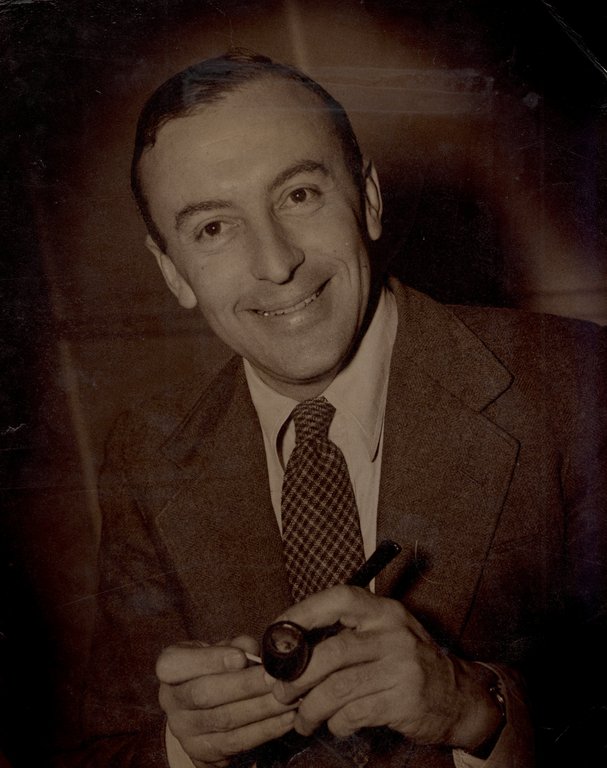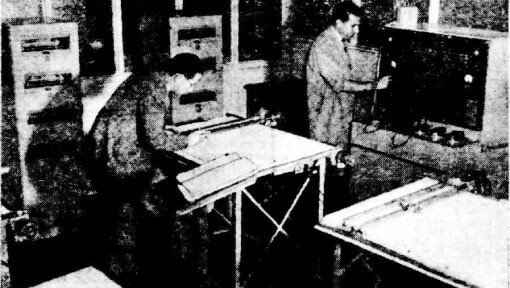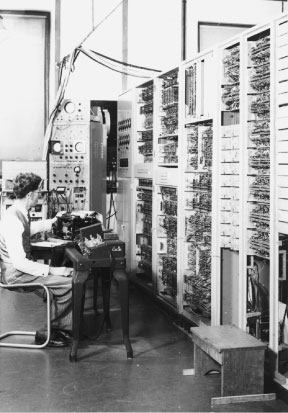The Beginning Of A New Science In Australia
By Barbara Ainsworth – Monash Museum of Computing History, Faculty of Information Technology, Monash University
In 1951 there was a major conference held at the University of Sydney which marked the beginning of a new science in Australia, Computer Science. It was organised by the CSIRO and the Department of Electrical Engineering, University of Sydney with a special international guest, Professor Douglas Hartree, from Cambridge University. Although they may not have realised it at the time, the participants were discussing the start of the computer age in Australia.

Prof David M Myers, School of Electrical Engineering, University of Sydney, date 1950.
The conference was officially entitled “Conference on Automatic Computing Machines” and was held over three days from 7-9 August, 1951. Prof David M. Myers, Department of Electrical Engineering, University of Sydney, proposed to hold a conference on automatic computing machines and invite Prof Hartree as early as 1949. The CSIRO agreed with the idea to invite Hartree for a conference and also asked him to undertake some consultation work for the CSIRO. They partially financed Hartree’s visit. 1 The conference papers were intended to introduce participants to the new developments in computing and programming techniques. It would also be an opportunity to display equipment. Trevor Pearcey from the CSIRO Division of Radiophysics publicly demonstrated his new high-speed digital computer, now called CSIRAC, for the first time. 2 Prof David Myers from Electrical Engineering and W.R. Blunden from the CSIRO Section of Mathematical Instruments (which was located within the EE Department, Uni of Sydney) exhibited their newly completed analog machine called a differential analyser.3 Both machines proved to be successful but it was a pivotal moment. The demonstrations contrasted the older analog equipment with the new digital machine.At the time of this conference in 1951, the full potential of digital computers was just starting to be realised. During the 1940s there were many developments, often secret, in electro-mechanical computation. While these machines could process information, they could not store the programming instructions. The first electronic, digital, general purpose, stored-program computer was achieved by Frederic C. Williams, Tom Kilburn, and Geoff Tootill, and ran its first program on 21 June 1948 at the University of Manchester, England. Trevor Pearcey, working with Maston Beard and their team at the Division of Radiophysics, built their own electronic digital stored-program computer in Sydney and ran their first successful tests in November 1949. It was the fourth stored-program computer in the world. It was called CSIR Mark 1 and this was later changed to CSIRO Mark 1 with the reorganisation of the research body in 1949. The name was changed again in 1956 when the computer was transferred to the University of Melbourne.

Newspaper photograph of the differential analyser at University of Sydney in 1951.
The conference was opened by Emeritus Professor Sir John Madsen (Chair of Electrical Engineering at Sydney University 1920-1949) and attended by nearly 200 participants. The guest speaker, Professor Douglas Hartree, was the Plummer Professor of Mathematical Physics at the University of Cambridge. He had built the first differential analyser in England in the 1930s with his research student A. Porter and was well acquainted with the technological developments in computation in both the UK and the USA. He was also personally acquainted with many scientists in Australia. His papers were focussed on the development of calculating machines, programming and numerical methods. The other speakers were mainly from the CSIRO and the University of Sydney including Trevor Pearcey, W.R. (Ross) Blunden, Maston Beard, and Prof David M. Myers. Pearcey had three papers and a joint paper with Maston Beard which covered aspects of their work in digital machines at the CSIRO and programming. Myers discussed analog computing devices in his own paper, his work on the differential analyser with Blunden as well as a joint paper on developments in equipment involving work in his department by students, B. Speedy (from Sydney Uni) and D.L. Hollway, and B.F.C. Cooper (part of CSIRO). A paper was also submitted from the University of Adelaide/School of Mines, South Australia and written by Prof E.O. Willoughby, Gordon Rose and W.G. Forte on their work to build an analog computer to solve polynomial equations with real coefficients. Notably all of these presenters had interesting and long careers in academia and research.There were 13 papers in all published in the conference proceedings;
-
Prof Hartree – Keynote speaker and guest from Cambridge
- UniversityIntroduction to automatic calculating machines.
- Automatic digital calculating machines.
- Introduction to programming.
- Numerical methods and automatic calculating machines.
-
Trevor Pearcey – CSIRO
- Programming of the C.S.I.R.O. digital machine.
- Programming for punched card machines.
- The functional design of an automatic computing machine.
-
Trevor Pearcey and Maston Beard – CSIRO
- Digital calculating machines used by the C.S.I.R.O.
-
David Myers – University of Sydney
- Some analogue computing devices
-
David Myers and Ross Blunden – University of Sydney and CSIRO
- The C.S.I.R.O. Differential Analyser
-
David Myers, D.L. Hollway, C.B. Speedy, B.F. Cooper – University of Sydney and CSIRO
- Some new developments in equipment for high-speed digital machines.
-
Ross Blunden – CSIRO
- Digital-analogue conversions.
-
E.O. Willoughby, G. Rose, W.G. Forte – University of Adelaide and SA School of Mines
- An Analog Computer to Solve Polynomial Matrices with Real Coefficients
There were sessions to discuss the papers and problems

Trevor Pearcey sitting in front of CSIR/CSIRO Mark 1.
The 1951 Conference on Automatic Computing Machines marks the beginning of a new science in Australia. Until the beginning of the 1950s, the work on computers had been regarded as a field dominated by mathematicians. Prof Myers later said that “many would agree that the 1951 conference was a turning point in Australia and that since that time computing became increasingly a study in its own right rather than a plaything of specialists.”4 Australian scientists had the opportunity to see for the first time an electronic, digital, general purpose computer with stored programming that even played music! Digital computing had arrived.
The dawn of Australia’s digital age will be celebrated atThe Riding the Digital Wave Summit being held at the University of Sydney on 30 September 2021.
1 Dr E.G. Bowen to Prof D.M. Myers 16 November 1949 NAA C3830 A8/8/1A Part 1; the CSIRO partially funded the costs for Hartree’s trip and the Australian National University also contributed funding.
2 The Australian Government research body Council for Scientific and Industrial Research (CSIR) dates 1926-1949 and replaced earlier bodies. CSIR was reorganised as the Commonwealth Scientific and Industrial Research Organisation (CSIRO) in 1949 onwards. The computing work at the Division of Radiophysics uses the prefix CSIR and later CSIRO with the digital electronic computer designated Mark 1. It later became called CSIRAC when transferred to Melbourne in 1955.3 A differential analyser is a mechanical analog computer designed to solve differential equations by integration and used a set of wheels and discs to complete the integration. The first practical differential analyser was built by Vannevar Bush at M.I.T. and Harold Locke Hazen between 1928-1931. Douglas Hartree and Arthur Porter built a copy of Bush’s design in England in1934 from Meccano and a full machine in 1935. These machines were still built into the 1950s but gradually became obsolete as digital computers were developed. Note David Myers worked with Hartree and Porter in the mid-1930s.
4 Myers, D.M. 1994 p.14 in Bennett, J.M. et al (eds.) Computing in Australia: the development of a profession. Pp9-14, Hale & Ironmonger, Sydney.
Further reading:
CSIRO and EE Department, University of Sydney (1952) Proceedings of Conference on Automatic Computing Machines held in the Department of Electrical Engineering, University of Sydney, August 1951. Melbourne: Commonwealth Scientific and Industrial Research Organization in conjunction with the Dept. of Electrical Engineering of the University of Sydney (220 p., [41] p. of plates)
McCann, D. (2008) Summary of main discussions of the 1951 Computer Conference in Museums Victoria Collections. https://collections.museumsvictoria.com.au/articles/2718
Bennett, J.M. et al (eds.) (1994) Computing in Australia: the development of a profession. Hale & Ironmonger, Sydney. This book has a series of articles including text by Trevor Pearcey and David Myers who both recall the first conference.
Images
Prof David M Myers, School of Electrical Engineering, University of Sydney, date 1950. Source University of Sydney Archives G3 224 2788. https://www.sydney.edu.au/arms/archives/media/me_objects/5800
Newspaper photograph of the differential analyser at University of Sydney in 1951.Source: The Sunday Herald, “Meet the Brain” 15 April 1951 p.1 (article re differential analyser at University of Sydney) https://trove.nla.gov.au/newspaper/article/18501167
Trevor Pearcey sitting in front of CSIR/CSIRO Mark 1, later called CSIRAC, in September 1951 just a month after the computer conference. It was located in the Madsen Building, University of Sydney. Source CSIRO Archives Scienceimage 3539 https://www.scienceimage.csiro.au/image/3539/

related posts
- Grandmother of the Web
- Who came to the first computer conference?
- CSIRAC: How to name your computer
- The media takes a ride on the digital superhighway
- A letter to my younger self, Helen Vorrath
- A letter to my younger self, Ann Moffatt
- The rise and fall of semiconductor manufacturing in Australia
- The Role of the ICT Community in the Future Resilience and Self-Reliance of Australia
- Book Review – A Thread Across The Ocean: The Heroic Story of the Transatlantic Cable. By John Steele Gordon
